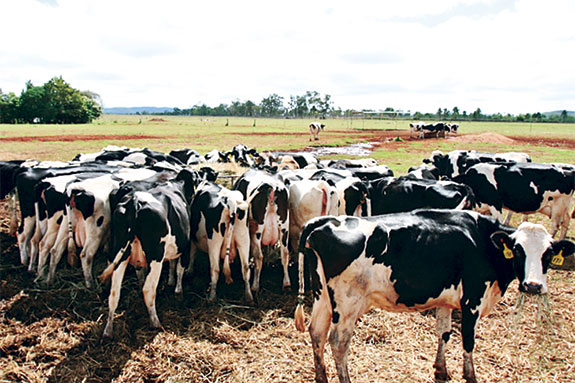Without ever speaking English, your cows are telling you tons about what they need. What if I told you your cows are telling you how to improve milk production? And they always tell the truth. These girls never lie.
CowSignals trains cattle farmers, feed consultants, breeding consultants, barn design consultants, vets and others involved in the dairy industry to improve cattle management through cows’ natural cues.
Trainers understand that just by visually observing cows, a dairyman can remove obstacles that may be obstructing optimal milk production.
“It CowSignals looks at very familiar things that a person sees day in and day out but has become numb to because they’ve seen it so many times,” Dr. Hubert Karreman, the only CowSignals trainer in the U.S., says.
Dr. Joep Driessen and Dr. Jan Hulsen, Dutch veterinarians and the founders of CowSignals, began training this new program in the spring of 2000. The inspiration for Driessen’s CowSignals stems from his deep passion for cows.
“I love to look at cows when they are laying down in the pasture, chewing and looking around very satisfied and relaxed. I like the sound of fresh grass being torn off when they rip it with their tongues,” Driessen says. “See the herd moving from left to right over the field, following the grazing leader. I try to learn from them to take it easy, look around and relax.”
Karreman did not grow up on a farm but has now spent over half of his life with dairy cows. Before deciding to be a veterinarian, Karreman was herdsman of a few different herds in Holland, New Hampshire and Pennsylvania.
He believes that since he didn’t grow up on a farm it was important he spent time working on farms to truly understand them.
After graduating from the University of Pennsylvania, Karreman began his career as a veterinarian. A colleague from Quebec mentioned the CowSignals book to Karreman as he was finishing his own book, “The Barn Guide to Treating Dairy Cows Naturally.”
Impressed by the training because of his Dutch background and his previous work in Holland, Karreman decided to attend a four-day training in the eastern part of the Netherlands to become a certified trainer.
As a CowSignals trainer, Karreman is invited to speak to groups of people who work closely with cattle. Throughout the hour-and-a-half slide show presentations, Karreman illustrates the multitude of visual cues cows are constantly giving to their caretakers.
Attendees of the workshops leave with a different perspective on how to observe their cattle. Instead of just simply looking at a herd, they are aware of what the signals mean.
One of Karreman’s examples from his CowSignals curriculum perfectly exhibits how the course’s training could improve the viability of a herd. A picture of a herd in a pasture is shown on the screen.

Most of the cows are around a hay bale feeder eating, while one cow is away from the bale, off to the side and looking at the camera.
After the group takes some time to analyze the photo, Karreman asks, “What’s wrong with this photo?”
The farmers realize this photo is illustrating a problem. Since cows are herd animals, they like to be doing things all together and not on their own, including eating.
The farmers can infer that something is wrong with the lone cow and create a solution.
The solution for this picture is simple: Set out another feeder to ensure all the cows are eating together. CowSignals, as Karreman says, “is that simple.”
“I don’t want to belittle it at all by saying it’s not rocket science, but it isn’t,” Karreman says. “It’s basically realizing if what’s in front of you is good for the cow or not, as far as milk production.”
Another example of how watching cow behavior can improve milk production is the way in which a cow stands up. It’s routine that a cow will lunge her head forward, bring up her back legs and then her front legs. If there is any sort of obstruction that causes stress every time she rises, milk production will decrease.
If time permits, Karreman will offer a hands-on portion where farmers will visit a local dairy to evaluate how it could improve in regards to what they have just discovered. The group walks away with a real demonstration of the signals, and the dairyman learns how he can improve his dairy.
Today, 220 certified CowSignals trainers in more than 32 countries present workshops to farmers. With training provided in English, Spanish, German, French and Dutch, anyone with a passion in improving the life of cattle can become a certified trainer.
CowSignals can give a dramatic look inside to cow behavior, barn design and dairy management. The training applies whether you have 10, 100, 1,000 or 10,000 cows.
Whether you are continuous housing or grazing. Or whether your operation is conventional or organic. It applies across the entire spectrum, since cows always tell the truth.
At the end of the day, the best thing we can do for our cows is to give them the most consistent milking experience possible; therefore, as dairy farmers you need to make a liner decision based on facts and not conceived advantages. PD
Meneses is an editorial intern with Progressive Dairyman .
Visit their website for more information regarding how you can get involved with CowSignals training.
PHOTO: One of veterinarian Hubert Karreman’s examples from his CowSignals curriculum perfectly exhibits how the course’s training could improve the viability of a herd. A picture of a herd in a pasture is shown on the screen (above). Most of the cows are around a hay bale feeder eating, while one cow is away from the bale, off to the side and looking at the camera. After the group takes some time to analyze the photo, Karreman asks, “What’s wrong with this photo?” Photo courtesy of Dr. Hubert Karreman.

-
Amanda Meneses
- Editorial Intern
- Progressive Dairyman






